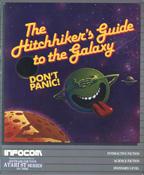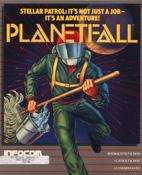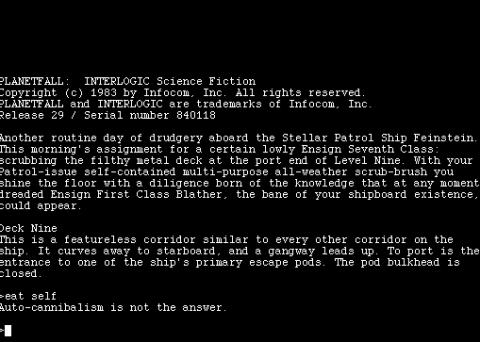TW Interview by Andrew Vanden Bossche
This spring, I interviewed Steve Meretzky, the legendary designer of storytelling computer games.
Meretzky created games before the advent of graphics, when all he had were words and the player’s intellect. His first game, Planetfall, in which the death of the beloved robot sidekick Floyd brought many young players to tears, is remembered vividly to this day by game industry veterans.
These early games were interactive fiction (IF), a type of storytelling software that bridged literary narrative and computer gaming. IF designers created environments that appeared onscreen entirely in text, and players typed in commands to move around, acquire objects, and make things happen. The games included complex puzzles and richly developed characters, environments, and storylines.
Meretzky graduated from MIT in 1979 with a degree in construction management, but he lasted only two years in that field before becoming a game tester for Infocom, a Boston-based IF developer. He went on to write Planetfall and many more titles for Infocom, including a collaboration with Douglas Adams on the interactive fiction version of The Hitchhiker’s Guide to the Galaxy.
 Today he is a VP at social game developer Playdom, but his work at Infocom is so widely regarded that he is one of only two interactive fiction writers to be admitted to the Science Fiction Writers of America.
Today he is a VP at social game developer Playdom, but his work at Infocom is so widely regarded that he is one of only two interactive fiction writers to be admitted to the Science Fiction Writers of America.
Interactive fiction games were a generation before me, and by the time I was old enough for them, graphics had long crowded IF out of the market.
Yet when I sat down to play Meretzky’s IF games nearly 25 years after they were written, they didn’t feel outdated at all. Despite the strangeness of the puzzles and the guessing at commands to get oneself around space stations and rapidly sinking lifeboats, it felt so fresh to interact with (literally) slimy diplomats and pompous officers in so many varied and clever ways that today’s games seemed primitive by comparison.
What’s remarkable to me, playing these games that were made before I was born, is how wonderful they still are. Just like films and special effects, graphics fade fast, but good writing never stops shining.
AVB: Did you write fiction before you started writing for Infocom?
SM: A little bit, but nothing that was published. I wrote a few science fiction short stories and sent them to magazines like Analog and Galaxy. I still have a thin folder of rejection letters from that period.
AVB: I know you started out as a game tester. What was that like, and how has game testing changed since then?
SM: Well, everyone assumes that “game tester” must be about the most fun job in the world, just playing games all day. But it’s actually quite a grind. For one thing, playing a game to find bugs, and to verify whether previous bugs have been fixed, takes some of the fun out of it. And what fun remains is certainly long evaporated by the 5,000th time you play the same game! That said, testing the Infocom games was quite a bit of fun, because the English language parser allowed for such a range of possible inputs. Many interesting (and often hilarious) bugs ensued, and there were many great ideas for testers to suggest to game writers. As a result—since it was so easy to add things to a game that was completely text based—game testers had a much bigger impact on the direction of an Infocom game than is the case today, where changes to the game in a graphical environment are so much more constrained.
 AVB: When you became a game designer, how did you adjust to writing a nonlinear narrative?
AVB: When you became a game designer, how did you adjust to writing a nonlinear narrative?
SM: It helped that I hadn’t done all that much writing up until that point, so I didn’t have many linear instincts that needed to be unlearned. And I’d played and tested a bunch of games with nonlinear narratives prior to beginning to design them, so I was used to thinking of narrative as at least a potentially nonlinear thing. Besides, I think all sorts of movies that have played with the linearity of narrative over the last few decades have shown that the importance of linearity is fairly overrated. Examples include Pulp Fiction, Run Lola Run, and Memento. In fact, I would love to do experiments in taking any linear narrative, breaking it up into pieces, randomly rearranging them, and then studying readers/viewers to see how much of the story they can still understand; my guess is “most.”
AVB: Do you think that anything intrinsic to interactive fiction has been applied to other genres of games?
SM: Narrative in an interactive medium first appeared in a big way in IF/adventure games and has now spread to almost every genre of game. I never would have guessed twenty years ago that narrative would be an almost automatic part of everything from simple casual games to action-heavy games such as first-person-shooters. Beyond that, not much. A lot of what made IF so special, such as the depth of the world and the feeling that you are going head to head in a battle of wits with the game’s author, has not made the translation from a text environment to a graphical environment.
AVB: When I tried to "eat self" in Planetfall, I got the message "cannibalism is not the answer." With almost infinite possibilities, how did you decide which commands to reward with quips like this?
SM: Testers were constantly suggesting these sorts of situations. Plus, whenever testers played, their games auto-scripted to files that I could read. I could see everything they tried for which the game didn’t have a non-generic response. When a tester suggested that there be a response for “eat self,” or if I decided it myself from reading a transcript, the system was so powerful but easy that I could include such a response in the game in literally a minute or two of work. So time was not much of a constraint for such quips. The one constraint was disk capacity—Planetfall, for example, was limited to an executable size of just over 100K. Often, toward the end of development, that limit would be reached, and then you could only add something to the game by taking something else out. In that case, it was a judgment call, based on both the estimate of how often a given response would be seen by a player, as well as the amusement level of the response. (We certainly wanted a number of obscure surprises, to encourage players to keep trying weird things.)

AVB: You moved from storytelling games to competitive online gaming when you went to work for WorldWinner. Was that a difficult transition? What are the commonalities between the two genres?
SM: There's very little commonality between the two genres. But over ten years passed between my time at Infocom and WorldWinner, so it wasn’t a single transition. In the intervening years, I worked on many graphic adventures, a few role-playing games, and even some action games while working at a THQ studio. However, the game that is most critical along that lengthy transition was one that I made in 1994, called Hodj ‘n’ Podj. It was the first game I created to ship on a CD-ROM as opposed to a floppy, so it had by far more of a focus on graphical elements and (especially) audio elements. But more importantly, it was the first game I did that was aimed at a more casual, mass-market audience. The term “casual game” hadn’t come into use yet, but if it had, we would have applied the term to Hodj ‘n’ Podj. The game was a two-player computerized board game, where one player plays Prince Hodj and one plays Prince Podj, searching a kingdom for two kidnapped princesses (Mish and Mosh). Movement is done in typical board game style, rolling dice and moving spaces along a network of roads, going through farmlands and mining towns and seaside fishing villages. Each time you enter a building along your travels, you get a casual mini-game—word searches, peg-jumping games, scrambled pictures, video poker, and so forth. So, obviously, this was quite a training ground for the types of experiences I’d be creating a few years later at WorldWinner.
AVB: What are you currently involved in at Playdom?
SM: As the company has grown to ten or so studios, my role these days tends to be one of flitting from studio to studio, giving advice, vetting design docs, mentoring designers, and commenting on the latest builds of each game. In general, it means I touch a lot of games but don’t touch any of them very deeply. My preference is to get a lot deeper on at least one game at a time, so I might be making a course correction to my role in order to make that more likely.
AVB: Are you writing anything besides games these days?
SM: Alas, no. During most of the first decade of the new century, I sometimes had time to dabble in personal writing projects on the side. But for the last two years at Playdom, I’ve been far busier for far longer than I’ve ever been before in any job, so I simply haven’t had any time for it recently.
AVB: The current generation of designers grew up playing your games. Do you see your influence (or the influence of first-generation storytelling games in general) in any of today's titles?
SM: Now and then, designers or other game developers will tell me that they got interested in joining the game industry because of playing my games. But there’s no obvious link (at least to me) between my work and their work. That might be because the IF genre is so different from all the commercially viable genres of today.
AVB: Lately, a game called DeathSpank reminded some of us that there hasn't been a funny game in a long time. In fact, humor isn't part of most games outside the interactive fiction and point-and-click adventure genres. Why do you suppose humor was such a big part of those games?
SM: Humor is sadly less prevalent in games than in just about any other entertainment medium. But it’s not quite as rare as all that. For example, one of my favorite games of the last few years is Portal, which certainly has some absolutely delightful humor (albeit dry and black). One thing that worked in favor of humor in adventure games is that they were the work of a single creator or a small creative team. Today so many games are the product of these huge factory teams, which aren’t conducive to generating humor.
AVB: Which science fiction dystopia would you say best describes the current game industry?
SM: Logan’s Run. The game industry tends to burn people out so quickly, it often seems like there are a handful of us graybeards and then a giant sea of people who all die off by the time they reach 30.
AVB: The theme of a recent issue of Talking Writing was "Is Print Dead?" How would you answer that question?
SM: Dead? Well, clearly not—I read a lovely paper copy of the New York Times while eating breakfast this morning. But there’s no denying that between reading news online and reading books on Kindles and iPads, print is in decline. I doubt it will ever go away, in much the same way that radio learned to coexist with television. But even if it did, it seems to me that what matters is the content of the words, whether they appear in ink on paper or pixels on a screen, and that content is in no danger of going away.
When he isn’t impersonating Jack Nicholson,  Andrew Vanden Bossche writes about video games and fails to maintain a blog.
Andrew Vanden Bossche writes about video games and fails to maintain a blog.
His column, Design Diversions, runs on industry insider blogs GameSetWatch and Gamasutra. His girlfriend and hamster sustain him in a not-quite-boring part of Brookline, Massachusetts.

